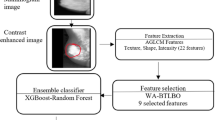Abstract
Authors presents an effective breast mammogram classification technique by the application of computer assisted tools for augmenting human functions, namely radiologists. Authors present AdaBoost with RBFSVM and Hybrid KNN–RBFSVM as base estimator by adaptively adjusting kernel parameters in RFBSVM (γ and C). KNN–RBFSVM classifier is developed by adaptively adjusting the kernel parameters of SVM using optimized parameters of KNN. In the proposed Hybrid KNN–RBFSVM algorithm, first weighted KNN is applied on training mammograms. Initially equal weights are assigned to each mammogram and updated weights are found. The updated weights from KNN are used as initial weights for RBFSVM. This Hybrid KNN–RBFSVM algorithm is used as base estimator in AdaBoost with number of estimators = 200, for prediction of test mammogram as benign or malignant. GLCM features are extracted from mammograms. Inconsistent and irrelevent features of mammogram affect the classification accuracy. Authors use proposed PreARM algorithm for features optimization. The classification results of the AdaBoost with DT, KNN, RBFSVM and Hybrid KNN–RBFSVM as base estimator are compared in terms of accuracy and area under ROC curve value. DDSM mammogram image dataset is used for experiment. The result shows, AdaBoost with Hybrid KNN–RBFSVM as base estimator achieves improved accuracy and AUC value compared to above ensembles.







Similar content being viewed by others
Abbreviations
- DT:
-
Decision tree
- KNN:
-
K nearest neighbor
- RBF:
-
Radial basis function
- SVM:
-
Support vector machine
- GLCM:
-
Grey level co-occurrence matrix
- PreARM:
-
Pre-processing step for association rule mining
- AUC:
-
Area under curve
- ROC:
-
Receiver operating characteristic curve
- DDSM:
-
Digital database for screening mammography
- ROI:
-
Region of interest
References
DeSantis C, Siegel R, Jemal A (2015) Breast Cancer Facts & Figures 2015–2016. Atlanta: Am Cancer Soc Inc. 2015:1–44
Freund Y, Schapire RE (1997) A decision-theoretic generalization of on-line learning and an application to boosting. J comput syst sci 55(1):119–139
Kuncheva LI, Whitaker CJ (2002) Using diversity with three variants of boosting: aggressive, conservative, and inverse. International Workshop on Multiple Classifier Systems. Springer, Berlin, Heidelberg, pp 81–90
Dietterich TG (2000) An experimental comparison of three methods for constructing ensembles of decision trees: bagging, boosting, and randomization. Mach Learn 40(2):139–157
Schwenk H, Bengio Y (2000) Boosting neural networks. Neural Comput 12(8):1869–1887
Li X, Wang L, Sung E (2008) AdaBoost with SVM-based component classifiers. Eng Appl Artif Intell 21(5):785–795
Choi JY, Kim DH, Plataniotis KN, Ro YM (2016) Classifier ensemble generation and selection with multiple feature representations for classification applications in computer-aided detection and diagnosis on mammography. Expert Syst Appl 46(15):106–121
Han J, Pei J, Kamber M (2011) Data mining: concepts and techniques. Elsevier, New York
Altman NS (1992) An introduction to kernel and nearest-neighbor nonparametric regression. Am Stat 46(3):175–185
Haralick RM, Shanmugam K (1973) Textural features for image classification. IEEE Trans Syst Man Cybern 3(6):610–621
Deshmukh J, Bhosle U (2016) SIFT with associative classifier for mammogram classification. In: Signal and information processing (ICONSIP), international conference on, IEEE, pp 1–5
Schapire RE, Singer Y (1998) Improved boosting algorithms using confidence-rated predictions. In: Proceedings of the eleventh annual conference on computational learning theory, ACM, pp 80–91
Vapnik VN (2000) The nature of statistical learning theory, 2nd edn. Springer, New York, p 131
Deserno TM, Soiron M, de Oliveir JE (2012) Texture patterns extracted from digitizes mammograms of different BI-RADS classes. Image Retrieval in Medical Applications Project, release, 1
Acknowledgements
The authors wish to express sincere gratitude to Dr. Thomas Deserno and co-authors, for permitting the use of IRMA VERSION OF DDSM LJPEG DATA for research work.
Author information
Authors and Affiliations
Corresponding author
Rights and permissions
About this article
Cite this article
Bhosle, U., Deshmukh, J. Mammogram classification using AdaBoost with RBFSVM and Hybrid KNN–RBFSVM as base estimator by adaptively adjusting γ and C value. Int. j. inf. tecnol. 11, 719–726 (2019). https://doi.org/10.1007/s41870-018-0241-x
Received:
Accepted:
Published:
Issue Date:
DOI: https://doi.org/10.1007/s41870-018-0241-x




